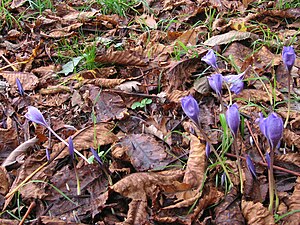
Leaf mold is a form of compost produced by the breakdown of shrub and tree leaves.
Due to the slow decaying nature of their lignin (cellulose) content, Autumn leaves break down far more slowly than most other compost ingredients, and therefore should be composted separately. This can be achieved either by placing the collected leaves in plastic bags (taking care to avoid collecting from areas that may be subject to high levels of pollution, e.g., roadsides), or in specially-constructed wire bins. To accelerate the breakdown process it is advisable to keep the leaves wet and avoid the drying effects of wind. The traditional wire enclosure may slow down the process by allowing the contents to dry out unless it is lined with cardboard or similar material.
Leaves alone take between one and two years to break down into rich humic matter with a smell reminiscent of ancient woodland. While not high in nutrient content, leaf mold is an excellent bulky and fibrous soil conditioner. To speed up the decomposition process, fallen leaves can be shredded, for instance by using a rotary lawn mower. Adding fresh grass clippings to autumn leaves will also speed the process. For best results watch the pile to keep moisture content high enough, observe temperatures, and turn the pile occasionally to improve the cycle.
Harvesting and processing leaves[edit | edit source]
Borrow your buddies pickup truck in the fall or spring and drive down the streets of any nicer upper middle-class neighborhoods, but not too nice (they might call the cops on you). If they are typical Americans, they will be giving away one of the best mulch/fertilizers bagged up and sitting there on the curb ready for you to steal. Fill up your truck with the bags, but not too full - you don't want to get pulled over for driving an overloaded vehicle. If you are a smooth talker you might even get the home owners to pay you to take away their 'trash' so that it is not sitting there until garbage day.
Take them home and pour the leaves (not the bags) through a shredder if you have one, or just dump them out in a protected area so the wind doesn't blow away you loot. An 8'x8' area with a 4' high chain link fence makes a nice container (or any fence for that matter - T-Bars and pallets work quite nicely). Fill it up and go back for more bags. Keep piling on until you are worn out - you will be surprised how fast they compact down, especially if shredded. You should be able to get an 80% reduction by shredding, plus another 50% by compaction, so 8x8x4x5x2=2560 cubic feet of unshredded leaves, assuming eight cubic feet per bag = 320 bags, assuming 20 bags per pickup truck load = 16 truck loads... so you better get moving. Beer helps - but pick a designated driver.
If there is not much rain that season, you might need to wet the area down occasionally. Be sure to dig down in a few areas to collect a bucket of earth worms whenever you go fishing. If you started in the fall, they will definitely be ready by spring. Feel free to mix in your fireplace ashes (after completely cool), it will help neutralize the acidity of the leaves. Just pull open one side of the fence, and dig in to the richest leaf mold that you can possibly steal.
If you have a particularly mean streak, borrow a different buddies truck, load up your leaf mold and drive around those very same neighborhoods offering to sell it back to those very same people you stole the raw materials from originally:-)